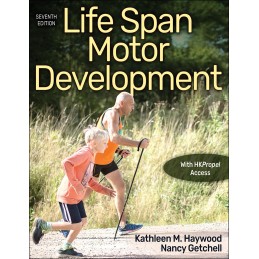Life Span Motor Development, Seventh Edition With HKPropel Access, is a leading text for helping students examine and understand how interactions of the developing and maturing individual, the environment, and the task being performed bring about changes in a persons movements. This model of constraints approach, combined with an unprecedented collection of video clips marking motor development milestones, facilitates an unmatched learning experience for the study of motor development across the life span.
The seventh edition expands the tradition of making the students experience with motor development an interactive one. Related online learning tools delivered through HK
Propel include more than 190 video clips marking motor development milestones to sharpen observation techniques, with interactive questions and 47 lab activities to facilitate critical thinking and hands-on application. The lab activities may be assigned and tracked by instructors through HK
Propel, along with chapter quizzes (assessments) that are automatically graded to test comprehension of critical concepts. The text also contains several updates to keep pace with the changing field::
- Content related to physical growth and development of the skeletal, muscle, and adipose systems is reorganized chronologically for a more logical progression.
- New material on developmental motor learning demonstrates the overlap between the disciplines of motor development and motor learning.
- New insights into motor competence help explain the relationship between skill development and physical fitness.
The text helps students understand how maturational age and chronological age are distinct and how functional constraints affect motor skill development and learning. It shows how the four components of physical fitness—cardiorespiratory endurance, strength, flexibility, and body composition—interact to affect a persons movements over the life span, and describes how relevant social, cultural, psychosocial, and cognitive influences can affect a persons movements. This edition comes with 148 illustrations, 60 photos, and 25 tables—all in full color—to help explain concepts and to make the text more engaging for students. It also retains helpful learning aids including chapter objectives, a running glossary, key points, sidebars, and application questions throughout each chapter.
Life Span Motor Development, Seventh Edition, embraces an interactive and practical approach to illustrate the most recent research in motor development. Students will come away with a firm understanding of the concepts and how they apply to real-world situations.
Note:: A code for accessing HK
Propel is included with all new print books.


 Dostawa
Dostawa
 Płatność
Płatność
 Zwroty
Zwroty
